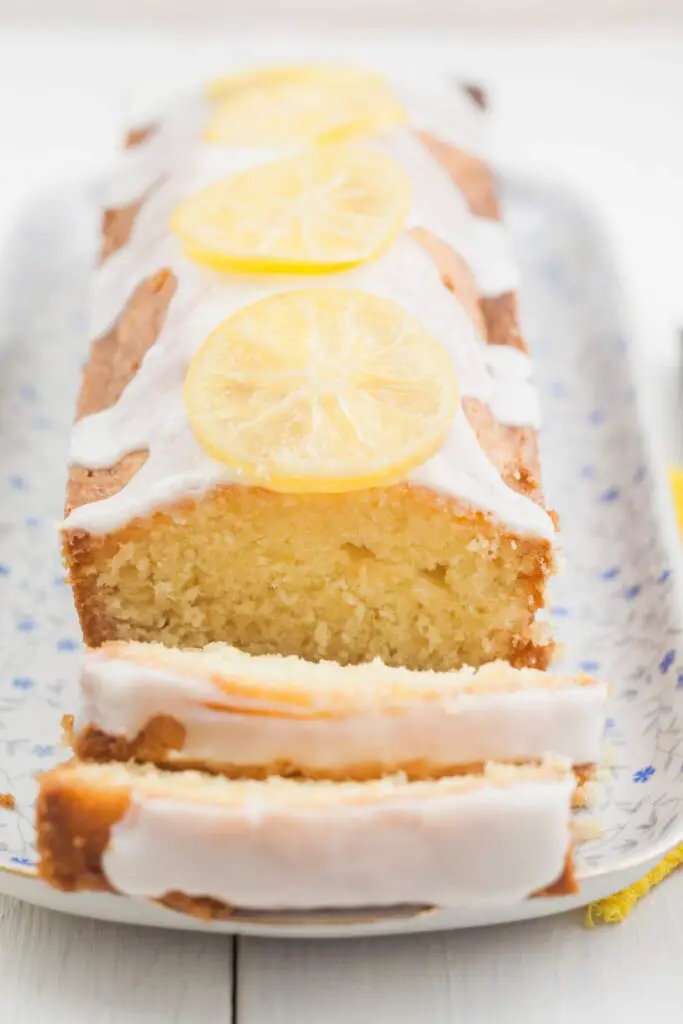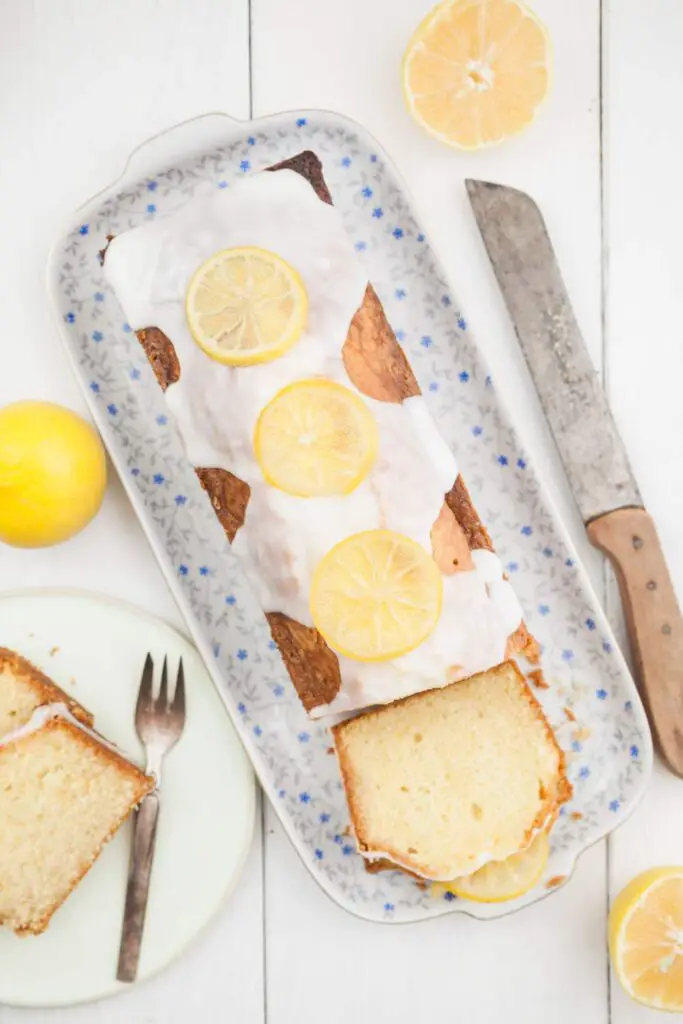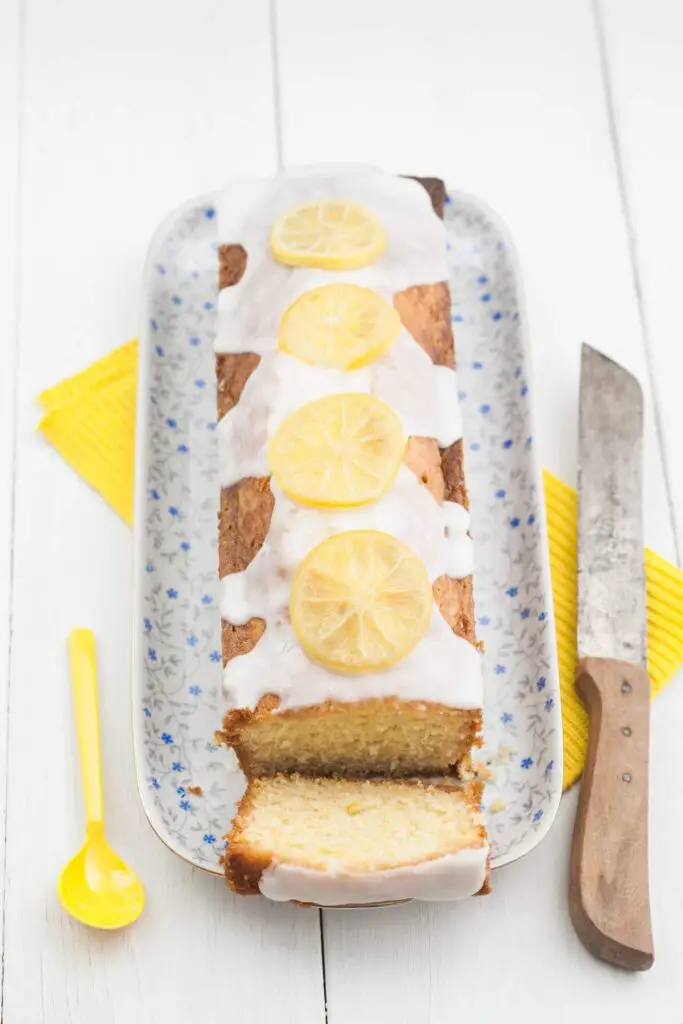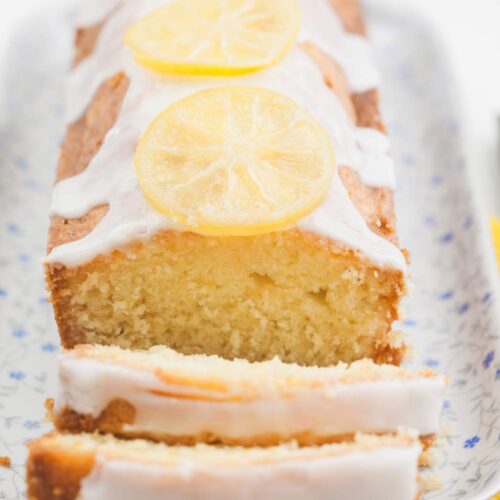If you’re a fan of citrus desserts, this lemon pound cake is about to become your new favorite treat. This lemon pound cake is delightfully moist, filled with the vibrant taste of fresh lemon, rich buttermilk, and a hint of lemon zest. Perfect for any occasion, it’s an easy recipe that promises to delight lemon lovers everywhere.

Ingredients
For the Cake
- All-purpose flour
- Baking soda
- Salt
- Buttermilk
- Grated lemon zest
- Fresh lemon juice
- Unsalted butter
- Granulated sugar
- Eggs
For the Syrup
- Water
- Granulated sugar
- Fresh lemon juice
For the Glaze
- Confectioners’ sugar
- Fresh lemon juice

How To Make Lemon Pound Cake
- Begin by zesting and juicing your lemons. Remember to zest the lemons before juicing, as it becomes difficult to do afterwards. While a rasp grater is ideal for zesting, any fine grater can also be used.
- In a mixing bowl, combine the flour, salt, and baking soda.
- Mix thoroughly with a whisk and set the bowl aside.
- In a separate bowl, combine the buttermilk, lemon zest, and lemon juice. Whisk until blended, then set aside.
- Using an electric mixer with the paddle attachment (or beaters), cream the butter and sugar together on medium speed for 3 to 4 minutes until the mixture becomes light and fluffy.
- After scraping down the sides of the bowl, add the eggs one at a time, beating thoroughly after each addition. Remember to scrape down the sides of the bowl once more.
- With the mixer set to low, gradually add one-quarter of the flour mixture, followed by one-third of the buttermilk mixture. Continue by adding another quarter of the flour mixture, then another third of the buttermilk mixture. Repeat this process, incorporating another quarter of the flour and the remaining buttermilk mixture. Finally, blend in the last portion of the flour mixture.
- Scrape the sides of the bowl, then mix briefly to ensure everything is thoroughly combined.
- Pour the cake batter into the prepared pans and level the surface using a rubber spatula.
- Bake for 55 to 65 minutes, or until the tops are golden and a toothpick inserted in the center comes out clean.
- Place the cakes on a cooling rack and let them cool in the pans for 10 minutes.
- Gently run a knife around the edges of the pans to release the cakes. Use the parchment paper handles to lift the cakes out of the pans and transfer them to the rack, keeping the parchment underneath. Allow the cakes to cool for approximately 1 hour.
- Prepare the syrup. In a saucepan, heat the water and sugar until boiling. Take off the heat and mix in the lemon juice.
- To prepare the glaze, combine confectioners’ sugar and lemon juice in a medium bowl, whisking until smooth. Adjust the consistency by adding more sugar or lemon juice if needed.
- Once the cakes have cooled, gently move them to serving plates. Slowly brush the warm syrup over the cakes, making sure to cover the sides as well, and allow it to absorb.
- Next, drizzle the glaze over the top of the cakes, letting it cascade down the sides.
- Allow the cakes to rest for about an hour to let the glaze firm up before serving.

Pro Tips for Perfect Lemon Loaf Cakes
Zest First, Then Juice: As mentioned in the instructions, zest the lemons before juicing. It’s much easier to zest when the lemons are whole. Use a rasp grater or fine grater to ensure you get just the yellow part of the peel, which contains the oils that provide a burst of lemon flavor. Avoid grating the white pith beneath the zest, as it can be bitter.
For accuracy, spoon the flour into your measuring cup and level it off with a knife. This prevents you from using too much flour, which could result in a dense cake. Do not scoop directly from the bag as this can pack the flour, leading to an inaccurate measurement.
When creaming the butter and sugar, make sure the butter is at room temperature. If it’s too cold, it won’t cream properly, and if it’s too soft, it won’t trap enough air, resulting in a dense cake. Beat on medium speed for 3-4 minutes until light and fluffy—this helps create a light texture in the cake.
When adding the eggs, be sure to add them one at a time, fully incorporating each one before adding the next. This ensures that the eggs are properly mixed into the batter and helps maintain an even texture throughout the cake.
Alternate adding the dry and wet ingredients in quarters and thirds (flour mixture and buttermilk mixture), starting and ending with the flour. This helps prevent overmixing and ensures the batter is evenly combined without overworking the gluten, which can cause a dense texture.
Ovens vary in temperature, so start checking the cakes at 55 minutes. Insert a toothpick or cake tester into the center. It should come out clean or with a few moist crumbs but no wet batter. Be cautious not to overbake, as this can dry out the cake.
After baking, let the cakes cool in the pans for 10 minutes before transferring them to the cooling rack. This allows them to set and prevents the cakes from breaking when removed from the pans.
Brush the syrup on the cake while it’s still warm. The warmth helps the syrup soak in more effectively, ensuring a moist and flavorful cake. Don’t rush the syrup application—take your time to let it soak into all the edges.
Adjust the glaze’s consistency to your preference. If you like a thicker glaze, add more confectioners’ sugar. If you want it thinner, add more lemon juice. You want it pourable but not too runny so that it stays on the cake without running off completely.
Storage Instructions
Once the glaze has set, store the cake at room temperature in an airtight container. This will keep it fresh for about 2-3 days. The cake will stay moist and flavorful, and the glaze will remain firm. Keep the cake in a cool, dry place to avoid condensation.
If you need to store the cake for longer than a few days, refrigerate it. Wrap the cake tightly in plastic wrap or place it in an airtight container to prevent it from drying out. It will stay fresh for up to a week. Before serving, let the cake come to room temperature for optimal flavor and texture.
To freeze the cake, ensure it’s completely cool before wrapping. Wrap the cakes tightly in plastic wrap and then in aluminum foil, or place it in a freezer-safe bag. For best results, freeze the cake without the glaze. Once ready to serve, thaw the cake at room temperature and then add the glaze just before serving for a fresh finish.
Individual slices can also be wrapped and frozen. This makes it easy to grab a slice whenever you want a treat.
Syrup: Store leftover syrup in a small airtight container in the fridge for up to 1 week. Reheat before using, as it will thicken when cooled.Glaze: If you have extra glaze, store it in the refrigerator in an airtight container. It will last about 1 week. Re-whisk before using to restore its smooth texture.
More Pound Cake

Lemon Pound Cake
Ingredients
For the Cake
- 3 cups all-purpose flour spooned into measuring cup and leveled-off with a knife
- ½ teaspoon baking soda
- ½ teaspoon salt
- 1 cup buttermilk low-fat is fine
- 2 tablespoons packed grated lemon zest
- 2 tablespoons fresh lemon juice
- 2 sticks 1 cup unsalted butter, softened
- 2¼ cups granulated sugar
- 3 large eggs
For the Syrup
- 2 tablespoons water
- 2 tablespoons granulated sugar
- 2 teaspoons fresh lemon juice
For the Glaze
- 1 cup confectioners' sugar
- 2 tablespoons fresh lemon juice
Instructions
- Preheat your oven to 350°F and adjust the rack to the center position. Prepare two 8½ x 4½-inch loaf pans by greasing them with nonstick spray. Next, line the longer sides of each pan with parchment paper strips, ensuring they extend out for easy removal later. Lightly spray the parchment-lined pans with nonstick spray once more.
- Begin by zesting and juicing your lemons. Remember to zest the lemons before juicing, as it becomes difficult to do afterwards. While a rasp grater is ideal for zesting, any fine grater can also be used.
- In a mixing bowl, combine the flour, salt, and baking soda.
- Mix thoroughly with a whisk and set the bowl aside.
- In a separate bowl, combine the buttermilk, lemon zest, and lemon juice. Whisk until blended, then set aside.
- Using an electric mixer with the paddle attachment (or beaters), cream the butter and sugar together on medium speed for 3 to 4 minutes until the mixture becomes light and fluffy.
- After scraping down the sides of the bowl, add the eggs one at a time, beating thoroughly after each addition. Remember to scrape down the sides of the bowl once more.
- With the mixer set to low, gradually add one-quarter of the flour mixture, followed by one-third of the buttermilk mixture. Continue by adding another quarter of the flour mixture, then another third of the buttermilk mixture. Repeat this process, incorporating another quarter of the flour and the remaining buttermilk mixture. Finally, blend in the last portion of the flour mixture.
- Scrape the sides of the bowl, then mix briefly to ensure everything is thoroughly combined.
- Pour the cake batter into the prepared pans and level the surface using a rubber spatula.
- Bake for 55 to 65 minutes, or until the tops are golden and a toothpick inserted in the center comes out clean.
- Place the cakes on a cooling rack and let them cool in the pans for 10 minutes.
- Gently run a knife around the edges of the pans to release the cakes. Use the parchment paper handles to lift the cakes out of the pans and transfer them to the rack, keeping the parchment underneath. Allow the cakes to cool for approximately 1 hour.
- Prepare the syrup. In a saucepan, heat the water and sugar until boiling. Take off the heat and mix in the lemon juice.
- To prepare the glaze, combine confectioners' sugar and lemon juice in a medium bowl, whisking until smooth. Adjust the consistency by adding more sugar or lemon juice if needed.
- Once the cakes have cooled, gently move them to serving plates. Slowly brush the warm syrup over the cakes, making sure to cover the sides as well, and allow it to absorb.
- Next, drizzle the glaze over the top of the cakes, letting it cascade down the sides.
- Allow the cakes to rest for about an hour to let the glaze firm up before serving.
